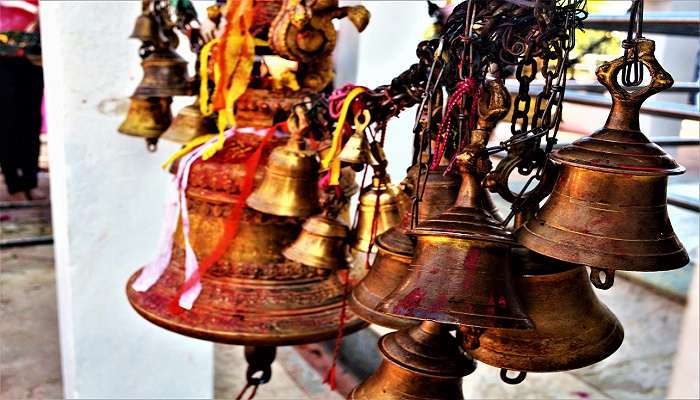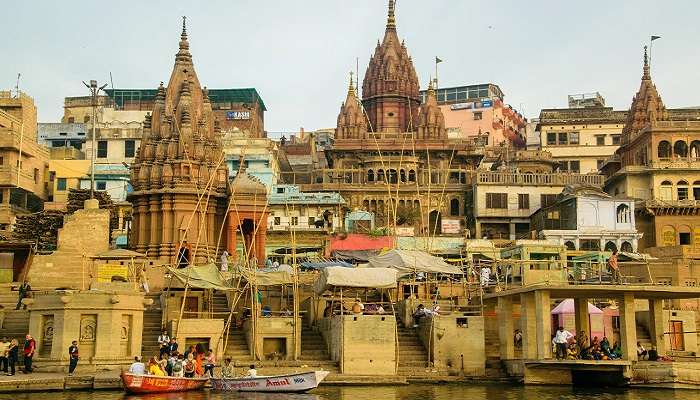A Sacred Hindu Pilgrimage Site Ratneshwar Mahadev Temple In Varanasi In 2026

Ratneshwar Mahadev Temple, located in Varanasi in the Indian state of Uttar Pradesh is an architectural marvel. The exemplary design and the unique architecture of the temple make it the most visited temple in Varanasi. Varanasi is a spiritual town located on the banks of the river Ganga. Famous for its serene ghats, magnificent temples, and picturesque location, Varanasi attracts many pilgrims, devotees, and travellers seeking solace and heavenly pleasure in this temple town of Uttar Pradesh. Ratneshwar Mahadev Temple in Varanasi is one such attraction. Set amidst the scenic location with an alluring view of the calm waters of River Ganga, The temple attracts many devotees for its mythological and legendary stories. Visit this mighty Ratneshwar Mahadev Temple in Varanasi for a divine and holistic experience.
The Legend Of Ratneshwar Mahadev Temple

The Ratneshwar Mahadev Temple in Varanasi is a holy temple dedicated to Lord Shiva. The temple is the epitome of beauty and architectural ingenuity and displays the rich culture and heritage of the city. Being a temple town, Varanasi is the abode of holy temples, and Ratneswar Mahadev Temple is one of them. The temple is located on the Manikarnika Ghat of the holy city of Varanasi. The temple is also called the Leaning Temple of Varanasi or the Kashi Karvat. The literal meaning is a temple in Kashi (Varanasi), which leans to one side (Karvat).
According to Hindu folklore, the Ratneshwar Mahadev Temple was built by a servant of Raja Man Singh for his mother, Ratna Bai, 500 years ago. Once the temple was fully constructed, the man boasted, saying that he had paid his mother’s debt. The man’s mother, Ratna Bai cursed the temple by saying that the debt to one’s mother can never be paid. As soon as she said this, the temple tilted to one side. This is how the temple became the Leaning Temple of Varanasi.
Must Read: Things To Do In Varanasi
The History Of The Ratneshwar Mahadev Temple

The actual time of the construction of the temple is not known. According to the revenue records, the temple was built from 1825-1830. There are different stories regarding the construction of the temple. According to some, the temple was built by the royal family of Amethi. Some historians suggest that the temple was built by Queen Baija Bai in the 19th century. Another story claims that it was built by Ratna Bai, a female servant of Queen Ahilya Bai of Indore. Ahilya Bai cursed the temple to learn as the servant named the temple after herself.
A surprising element is that the photos from the 1860s do not show that the Ratneshwar Mahadev temple was leaning at that time. The lean of the temple could be because of a structural problem, a waterlogged foundation, silt and sand beneath the temple, or the curse. Another surprising factor is the presence of the Ratneshwar Mahadev temple near the edges of the River Ganga. The Garbha Griha or the Sanctum Sanctorum of the temple, which is the main holy shrine of the temple remains submerged in the holy waters of Ganga for most of the year. According to a historian, in the 19th century, when the temple was underwater, the priests used to dive into the sacred waters of the river Ganga to perform worship and conduct holy rites.
The Architecture Of The Temple

The Ratneshwar Mahadev Temple is tilted 9 degrees to the northwest. The temple’s architecture resembles that of the construction of the North Indian Temples. The temple has a height of approximately 13 m. The temple is elegantly constructed in the classical North Indian Style with a high-rising Shikhara and a phamsana Mandapa. Due to its proximity to the holy Ganga River, the Garbha Griha, or the Sanctum Sanctorum of the temple remains submerged in water for most of the year.
Unlike other temples located in the holy town of Varanasi, the site of the temple appears unusual. The temple’s low level allows the water to reach up to the Shikhara of the temple. Despite the temple being underwater for most of the year, the temple is well preserved and captures the attention of people visiting the Manikarnika Ghat. The Ratneshwar Mahadev Temple is located on the Manikarnika Ghat of Varanasi just in front of the Tarkeshwar Mahadev Temple, which was built by Ahilya Bai Holkar, the queen of Indore in the year 1795. The Tarkeshwar Mahadev Temple is the place where it is believed that Lord Shiva recited the Taraka Mantra ( The Salvation Mantra). Between the temple and the Tarkeshwar Mahadev Temple is a spot that is said to be the holiest in Varanasi by James Prinsep in 1832.
Suggested Read: Places To Visit In Varanasi
Places To Explore Nearby

One of the most photographed locations in Varanasi, the Ratneshwar Mahadev Temple attracts pilgrims and tourists due to its leaning tilt. The tilt of the temple is said to be nine degrees, while that of the Leaning Tower of Pisa is four degrees.
The Ratneshwar Mahadev Temple is located on the Manikarnika Ghat and has some places to explore nearby. Explore the magnificent Kashi Vishwanath Temple, which is dedicated to Lord Shiva. Manikarnika ghat is home to several small yet ancient temples that capture visitors’ attention. Also, explore the other serene ghats of the temple town of Varanasi. Be a spectator to the divine aura of the ghats in Varanasi during the evening aarti which is a sight to behold.
Further Read: Waterfalls Near Varanasi
Now that you have a complete guide to the ancient Ratneshwar Mahadev Temple in Varanasi and its historical significance, don’t wait any further and plan your trip to Varanasi to witness the stunning architecture of the divine Temple located on the Manikarnika Ghat of Varanasi and immerse yourself in the legendary significance of the temple. Witness the divine evening aarti at the serene ghats of Varanasi. Hurry up and plan your next trip to this temple town of Varanasi. Don’t wait any further and book your tickets now.
For our editorial codes of conduct and copyright disclaimer, please click here.
Cover Image Credit: Dennis Jarvis for wikimedia commons
Frequently Asked Questions About Ratneshwar Mahadev Temple
Which is the nearest airport to Ratneshwar Mahadev Temple in Varanasi?
The nearest airport to Ratneshwar Mahadev Temple in Varanasi is the Lal Bahadur Shastri Airport. Also known as the Babatpur Airport or the Varanasi Airport. Easy transportation is available from the airport to the Ratneshwar Mahadev Temple.
Which is the best time to visit Ratneshwar Mahadev Temple in Varanasi?
The best time to visit Ratneshwar Mahadev Temple is from October - March. As the City experiences hot weather in Summer, it is best to visit the city during the winter.
What are some affordable accommodations near Ratneshwar Mahadev Temple in Varanasi?
Here are some of the best accommodations that offer a budget-friendly and comfortable stay to its guests. Ramada Plaza by Wyndham JHV Varanasi Taj Ganges Varanasi Hotel Temple on the Ganges Hotel Heritage Inn At Assi Ghat Palace on the Ganges- A Heritage Hotel
What are some famous tourist spots in Varanasi?
The nearby attractions in Varanasi include Nepali Temple, Kashi Vishwanath Temple, Dhamek Stupa, Dashashwamedh Ghat, Durga Temple, Tulsi Manas Mandir, Manikarnika Ghat, Lalita Ghat, Assi Ghat, Ramnagar Fort.
How much time is required to cover Ratneshwar Mahadev Temple and other tourist spots in Varanasi?
Ratneshwar Mahadev Temple requires 1-2 hours for proper sightseeing. The other tourist spots in Varanasi city can be covered in a span of 3 days.
People Also Read:
Meenakshi Temple Lempuyang Temple Kashi Vishwanath Temple

Unveil the hidden treasures of the globe and turn every travel dream into reality. As a Content Writer, I am passionate enough to craft stories from ancient wonders to modern marvels. My words paint the picture-perfect itinerary for unforgettable experiences. Let my words be your trusted guide to immerse in the diverse culture and discover the beauty of the unknown.











